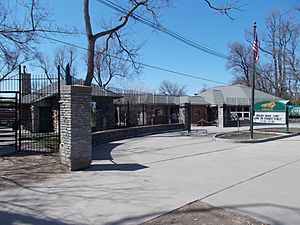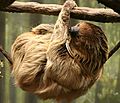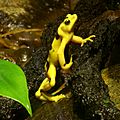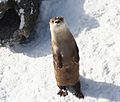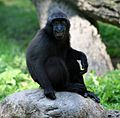Buffalo Zoo facts for kids
 |
|
| Date opened | 1875 |
|---|---|
| Location | 300 Parkside Ave, Buffalo, New York, United States |
| Land area | 23.5 acres (9.5 ha) |
| No. of animals | 1200 |
| Annual visitors | 400,000 |
| Memberships | AZA |
| Major exhibits | Arctic Edge, Rainforest Falls, Sea Lion Cove, Otter Creek, Vanishing Animals, Rhino Yards, Giraffes, Kookaburra Corner, EcoStation, Heritage Farm (Children's Zoo) |
| Website | |
|
Buffalo Zoo Entrance Court
|
|
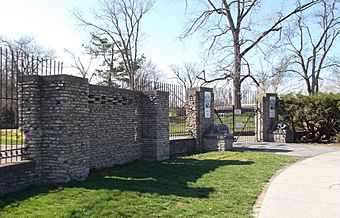
Buffalo Zoo Entrance Court, April 2013
|
|
| Location | 300 Parkside Ave. Buffalo, New York |
| Area | less than one acre |
| Built | 1935-1938 |
| Architect | Brent, John Edmonston |
| NRHP reference No. | 13000305 |
| Added to NRHP | May 22, 2013 |
The Buffalo Zoo, located at 300 Parkside Avenue in Buffalo, New York, is one of the oldest zoos in the United States. It first opened its doors in 1875. Each year, about 400,000 people visit the Buffalo Zoo. It is the second most popular tourist spot in Western New York, right after Niagara Falls.
The zoo covers 23.5 acres (9.5 ha) within Buffalo's Delaware Park. It is home to many different kinds of animals from all over the world. You can also see more than 320 different types of plants there. The Buffalo Zoo is open every day of the year.
Contents
Exploring the Buffalo Zoo's History
The Buffalo Zoo's story began in the mid-1800s. A man named Jacob E. Bergtold, who worked with furs in Buffalo, gave two deer to the city. To give the deer space to roam, Elam R. Jewett, a newspaper publisher, offered to keep them on his land.
At the same time, plans were being made for a new city park, now known as Delaware Park. Mayor William F. Rogers hired a famous landscape architect, Frederick Law Olmsted, to include a zoo in the park's design. Five years after the deer were donated, more animals joined the collection. In 1875, the first permanent building was built, officially creating the Buffalo Zoological Gardens.
Zoo Expansion During the Great Depression
The zoo grew a lot during the Great Depression. It became a major project for the Works Progress Administration, a program that created jobs. One of the new buildings was the Buffalo Zoo Entrance Court. It was designed by African-American architect John Edmonston Brent. This entrance was built between 1935 and 1938. The Buffalo Zoo Entrance Court was added to the National Register of Historic Places in 2013.
Focusing on Conservation and Education
Over the next few decades, more exhibits and buildings were added to the zoo. These included the Reptile House in 1942 and the Children's Zoo in 1965. A Giraffe House and a Veterinary Hospital were built in 1967. The Gorilla Habitat Building opened in 1981.
In the 1980s and 1990s, the zoo's goals began to change. Under the leadership of Minot Ortolani, the zoo started to have fewer animals. Instead, it focused on breeding endangered species. This helped animals that might not survive in the wild. The zoo also started to teach visitors more about animals and their natural homes. Dr. Donna M. Fernandes was the President/CEO from 2000 to 2017. Norah B. Fletchall took over in 2017.
Modernizing the Zoo's Habitats
In 2002, the zoo announced a big plan to improve the park over 15 years. They planned new areas for visitors and more natural-looking homes for the animals. These plans included the Asian River and Highlands Zone, African Watering Hole, Arctic Edge, and the Wonders of Water Children's Zoo.
The first part of this plan brought new exhibits like Vanishing Animals, EcoStation, Otter Creek, and Sea Lion Cove. This first phase finished on September 10, 2008, with the opening of the South American Rainforest. This amazing area has a two-story waterfall, many colorful birds, and other rainforest animals.
In the fall of 2015, the $14 million Arctic Edge exhibit opened. It was first home to Arctic wolves, lynxes, and polar bears. In 2016, Arctic foxes replaced the wolves because they fit the exhibit better. Today, Arctic Edge is home to two polar bears named Anana and Luna.
In March 2018, the zoo's Reptile House closed for a big renovation. It reopened on May 24, 2019, as the Donna M. Fernandes Amphibian and Reptile Center. It now has a new roof, updated exhibits, and interactive displays.
In August 2018, the zoo announced that its two Asian elephants, Jothi and Surapa, would move to the Audubon Zoo in New Orleans. This was because the Buffalo Zoo could no longer care for them. They moved later that year. As of 2022, black rhinos live in the former elephant habitat.
In early June 2020, a red-footed tortoise named 'Red' was reported stolen from the zoo. Police searched for the tortoise, but it was never found.
Amazing Animals at the Zoo
The Buffalo Zoo is home to many different kinds of animals. Here are some of the species you can see:
- Mammals
- Birds
- Reptiles
|
|
|
- Amphibians
- Anderson's crocodile newt
- Axolotl
- Cane toad
- Dyeing poison frog
- Green and black poison dart frog
- Hellbender
- Mission golden-eyed tree frog
- Panamanian golden frog
- Puerto Rican crested toad
- Solomon Islands leaf frog
- Yellow-banded poison dart frog
- Fish
- Cichlids
- Common pleco
- Magdalena River stingray
- Ocellate river stingray
- Silver dollar fish
- Spotted Rafael catfish
- Invertebrates
- Blue death feigning beetle
- Brazilian greysmoke spider
- Chaco goldenknee tarantula
- Chilean rose tarantula
Images for kids
See also
 In Spanish: Zoológico de Búfalo para niños
In Spanish: Zoológico de Búfalo para niños




